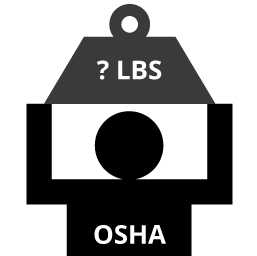We use cookies to make your experience better. To comply with the new e-Privacy directive, we need to ask for your consent to set the cookies. Learn more.
OSHA Lifting Limits Demystified
The Occupational Safety and Health Administration responds to dozens of letters every year to clarify their rules. One of the most common sources of confusion, as reflected in the OSHA Standard Interpretations posted on the Administration's website, concerns the manual lifting of heavy loads. What's the official weight limit that employers can ask workers to lift, writers ask?
The simple answer is that there are no OSHA lifting limits. In a 2004 reply to Kemberly Ladner, who asks if there's "a policy or guide which states the maximum weight a person may lift," Richard E. Fairfax, then-Director of the OSHA Directorate of Enforcement Programs, replied, "OSHA does not have a standard which sets limits on how much a person may lift or carry."

But that doesn't mean employers can require staff to manually lift or carry just anything, no matter how heavy it is. As Fairfax explains, there are two tools that OSHA can use when workers are being forced to enact dangerous lifts without the aid of a Lift Table, Bin Dumper, or other material handling equipment matched to the task: the NIOSH Lifting Equation and the General Duty Clause of the OSH Act.
The NIOSH Lifting Equation
The National Institute for Occupational Safety and Health is OSHA's sister agency, devoted to research on preventing injuries at work. Meanwhile, OSHA focuses on creating and enforcing regulations, informed by the work of NIOSH.
In his 2004 Standard Interpretation, Fairfax recommends using the NIOSH Lifting Equation to determine the risk of injury based on weight and a complex range of complicating factors.
The NIOSH Lifting Equation’s Recommended Weight Limit equals the Load Constant times the Horizontal Multiplier times the Vertical Multiplier times the Distance Multiplier times the Asymmetric Multiplier times the Frequency Multiplier times the Coupling Multiplier. For brevity's sake, it's written: RWL = LC x HM x VM x DM x AM x FM x CM.
That's pretty complicated, but you can always just use this RWL Calculator, kindly provided by the Canadian Centre for Occupational Health and Safety.
The General Duty Clause of the OSH Act
If employers knowingly require dangerous lifts without providing material handling equipment, OSHA may cite them for violating the General Duty Clause of the OSH Act. Despite the total lack of ergonomics guidelines in OSHA regulations, OSHA uses the General Duty Clause to prevent employers from continuing to subject workers to serious ergonomic risks.
The General Duty Clause can be found in Section 5(a)(1) of the OSH Act of 1970. It states that "Each employer shall furnish to each of his employees employment and a place of employment which are free recognized hazards that are causing or are likely to cause death or serious physical harm to his employees."
Dangerous lifts can definitely cause serious physical harm, potentially subjecting employers to hefty OSHA fines. So what should employers do if their work involves moving heavy materials around a facility?
The answer is to provide material handling equipment to do the heavy lifting. Lift Tables from Solus Group can handle loads up to 6,000 pounds, while Bin Dumpers automatically lift and empty virtually any container. Even equipment as simple as an Order Picking Cart will save staff from carrying heavy loads, risking musculoskeletal injury in the process.
While no clear OSHA lifting limits exist, employers should always provide ergonomic material handling equipment instead of requiring manual lifts. Otherwise, they're flirting with disaster.
References:
Fairfax, Richard. “Standard Interpretations, Ms. Kemberly M. Ladner.” OSHA. Occupational Safety and Health Administration, United States Department of Labor, 29 March 2004. Web. 30 Nov. 2016.
Waters, Thomas, Vern Putz-Anderson and Arun Garg. “Applications Manual for the Revised NIOSH Lifting Equation.” CDC. Centers for Disease Control and Prevention, Jan. 1994. PDF. 30 Nov. 2016.
